

Scientia Silvae Sinicae ›› 2023, Vol. 59 ›› Issue (7): 35-44.doi: 10.11707/j.1001-7488.LYKX20220865
• Frontier & focus: Functional traits of woody plants • Previous Articles Next Articles
Xinhao Li1,2( ),Dehuai Zhang3,Zhaosen Zhang4,Jian Li3,Jun Cao3,Jichao Wei5,Xiaomeng Wu1,2,Yun Tian1,2,Peng Liu1,2,Haiqun Yu6,*
),Dehuai Zhang3,Zhaosen Zhang4,Jian Li3,Jun Cao3,Jichao Wei5,Xiaomeng Wu1,2,Yun Tian1,2,Peng Liu1,2,Haiqun Yu6,*
Received:2022-12-06
Online:2023-07-25
Published:2023-09-08
Contact:
Haiqun Yu
E-mail:458819027@qq.com
CLC Number:
Xinhao Li,Dehuai Zhang,Zhaosen Zhang,Jian Li,Jun Cao,Jichao Wei,Xiaomeng Wu,Yun Tian,Peng Liu,Haiqun Yu. Seasonal Variations in Carbon Fluxes and Their Responses to Environmental Factors in a Pinus tabuliformis Plantation Ecosystem in Miyun, Beijing[J]. Scientia Silvae Sinicae, 2023, 59(7): 35-44.

Fig.1
Daytime net ecosystem CO2 production (NEP) as a function of incident photosynthetically active radiation (PAR) for the non-growing season (a) and growing season (b) Half-hourly NEP was bin-averaged with a PAR increment of 50 μmol photons·m?2s?1. Bars indicate standard errors. Light response curves were fit with Eq. (1)"

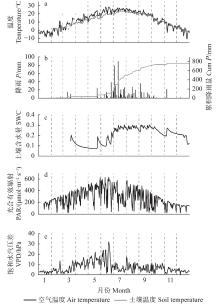
Fig.2
Dynamics in daily means or sums of environmental variables a:Daily means of air temperature (Ta) and soil temperature at a depth of 10 cm (Ts). b: Daily sums of precipitation (P) and cumulative precipitation (Cum P). c:Daily means of soil water content at a depth of 10 cm (SWC). d:Daily means of photosynthetically active radiation (PAR). e,:Daily means of vapor pressure deficit (VPD)."

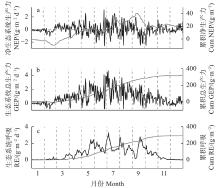
Fig.3
Seasonal variations of ecosystem carbon fluxes a:Daily sums of net ecosystem production (NEP) and cumulative net ecosystem production (Cum NEP). b: Daily sums of gross ecosystem production (GEP) and cumulative gross ecosystem production (Cum GEP). c: Daily sums of ecosystem respiration (RE) and cumulative ecosystem respiration (Cum RE)."

Table 1
Cumulative ecosystem carbon fluxes"
| 日期 Date | 时长 Length/d | 生态系统净生产力累积量 Cumulative net ecosystem production/(g·m?2) | 生态系统总生产力累积量 Cumulative gross ecosystem production/(g·m?2) | 生态系统呼吸累积量 Cumulative ecosystem respiration/(g·m?2) | |
| 全年 Annual | 01-01—12-31 | 365 | 24.16 | 315.22 | 291.06 |
| 生长季 Growing season | 04-01—10-31 | 214 | 14.92 | 288.80 | 273.88 |
| 生长旺期 Peak growing season | 06-01—08-31 | 92 | 11.73 | 105.86 | 94.13 |

Fig.4
Daily sums of net ecosystem production (NEP) as a function of both gross ecosystem production (GEP) and ecosystem respiration (RE) under different soil water content conditions The growing season is defined as the period from April to October, and the peak growing season is defined as the period from June to August."
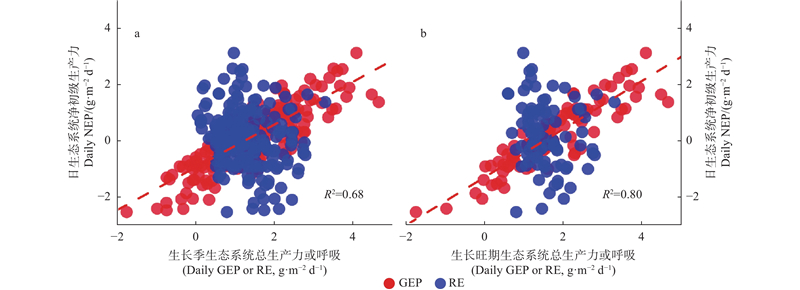

Fig.5
Half-hourly daytime net ecosystem production (NEP) as a function of incident photosynthetically active radiation (PAR) during the growing The growing season is defined as the period from April to October. Half-hourly NEP was bin-averaged into 50 μmol·m?2s?1 PAR increments. Bars indicate standard errors. Light response curves were fit with Eq. (1)."
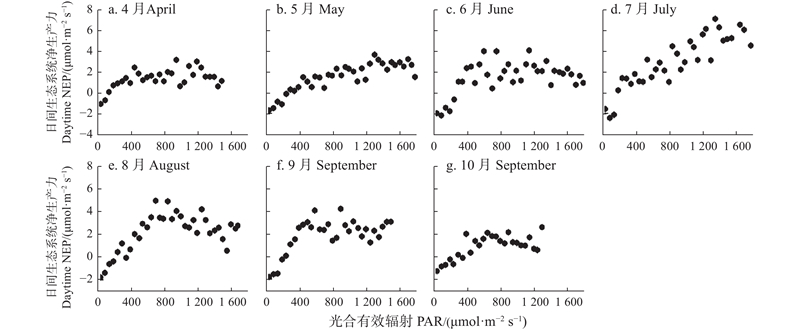
Table 2
Monthly physiological parameters values during the growing season"
| 表观量子 效率 Apparent quantum yield | 最大光合 速率 Maximum apparent photosynthetic capacity/ (μmol·m?2s?1) | 日间生态系统呼吸 Daytime ecosystem respiration/ (μmol·m?2s?1) | 决定系数 Coefficient of determination | |
| 4月April | 0.027±0.059 | 4.38±2.31 | 1.80±2.70 | 0.47 |
| 5月May | 0.013±0.008 | 6.53±1.00 | 2.22±0.99 | 0.85 |
| 6月June | 0.054±0.097 | 6.83±3.28 | 4.05±3.65 | 0.54 |
| 7月July | 0.018±0.021 | 10.39±2.98 | 2.75±2.56 | 0.67 |
| 8月August | 0.047±0.072 | 7.31±2.82 | 3.45±3.22 | 0.61 |
| 9月September | 0.056±0.082 | 7.23±2.70 | 3.79±3.08 | 0.69 |
| 10月October | 0.023±0.039 | 4.22±1.54 | 2.09±1.88 | 0.65 |
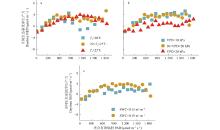
Fig.6
Half-hourly daytime net ecosystem production (NEP) as a function of incident photosynthetically active radiation (PAR) under different environmental conditions during the peak growing season The peak growing season is defined as the period from June to August. Half-hourly NEP was bin-averaged into 100 μmol·m?2s?1 PAR increments. Bars indicate standard errors. Light response curves were fit with Eq. (1)."

Table 3
Physiological parameters values under different environmental conditions during the peak growing season"
| 表观量子效率 Apparent quantum yield | 最大光合速率 Maximum apparent photosynthetic capacity/ (μmol·m?2s?1) | 日间生态系统呼吸 Daytime ecosystem respiration/ (μmol·m?2s?1) | |
| Ta<20 ℃ | 0.012±0.309 | 1.62±10.04 | 2.69±1.74 |
| 20 ℃<Ta<25 ℃ | 0.072±0.175 | 8.05±5.25 | 4.33±5.86 |
| Ta>25 ℃ | 0.045±0.092 | 8.02±5.00 | 4.30±4.69 |
| VPD<10 hPa | 0.026±0.024 | 9.18±1.74 | 3.18±2.06 |
| 10 hPa<VPD< 20 hPa | 0.046±0.096 | 8.48±4.13 | 3.93±4.89 |
| VPD>20 hPa | 0.006±0.011 | 5.25±3.59 | 2.05±1.82 |
| SWC<0.15 m3·m?3 | 0.026±0.057 | 6.00±2.94 | 3.18±3.52 |
| SWC>0.15 m3·m?3 | 0.075±0.233 | 8.26±7.03 | 4.62±7.82 |
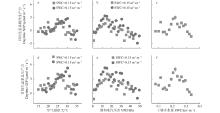
Fig.7
Reponses of half-hourly daytime net ecosystem production (NEP) and gross ecosystem production (GEP) to air temperature (Ta), vapor pressure deficit (VPD), and soil water content (SWC) during the peak growing season The peak growing season is defined as the period from June to August. Half-hourly NEP and GEP was bin-averaged into 1 ℃ Ta (a, d), 2 hPa VPD (b, e), and 0.015 m3·m?3 SWC (c, f) intervals, respectively. Bars indicate standard error."

Table 4
Parameter values describing the response of half-hourly daytime net ecosystem production (NEP) and gross ecosystem production (GEP) to air temperature (Ta), vapor pressure deficit (VPD), and soil water content (SWC) at the site during the peak growing season in 2021"
| 自变量 Independent variable | 土壤水分条件 Soil moisture condition | 因变量 Dependent variable | a | b | c | 决定系数 Coefficient of determination |
| Ta | 土壤含水量<0.15 m3·m?3 Soil water content<0.15 m3·m?3 | NEP | ?0.02±0.02 | 0.85±0.77 | ?8.95±9.08 | 0.32 |
| GEP | ?0.02±0.01 | 0.89±0.77 | ?8.66±9.10 | 0.26 | ||
| VPD | NEP | ?0.01±0.01 | 0.19±0.15 | ?0.71±1.45 | 0.47 | |
| GEP | ?0.01±0.01 | 0.23±0.14 | ?0.25±1.36 | 0.43 | ||
| Ta | 土壤含水量>0.15 m3·m?3 Soil water content>0.15 m3·m?3 | NEP | ?0.04±0.02 | 2.01±0.92 | ?24.70±11.71 | 0.57 |
| GEP | ?0.04±0.02 | 2.26±1.09 | ?27.13±13.89 | 0.56 | ||
| VPD | NEP | ?0.01±0.01 | 0.19±0.12 | 0.04±1.30 | 0.63 | |
| GEP | ?0.01±0.01 | 0.26±0.12 | 1.51±1.34 | 0.66 | ||
| SWC | ? | NEP | ?135.80±98.50 | 56.63±41.75 | ?4.38±4.02 | 0.37 |
| SWC | GEP | ?154.70±112.70 | 62.68±47.82 | ?3.17±4.61 | 0.37 |
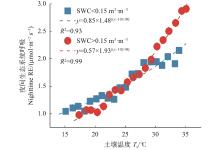
Fig.8
The relationships between half-hourly nighttime ecosystem respiration (RE) and soil temperature (Ts) during the peak growing season The peak growing season is defined as the period from June to August. Half-hourly RE was bin-averaged into 1 ℃ Ts intervals. Error bars indicate standard errors. Curves were fit with Eq. (2)."

|
李鑫豪, 田文东, 李润东, 等. 北京松山落叶阔叶林生态系统水热通量对环境因子的响应. 植物生态学报, 2021, 45 (11): 1191- 1202.
doi: 10.17521/cjpe.2021.0106 |
|
|
Li X H, Tian W D, Li R D, et al. Responses of water vapor and heat fluxes to environmental factors in a deciduous broad-leaved forest ecosystem in Beijing. Chinese Journal of Plant Ecology, 2021, 45 (11): 1191- 1202.
doi: 10.17521/cjpe.2021.0106 |
|
| 刘 晨, 张春雨, 赵秀海. 采伐干扰对吉林蛟河针阔混交林生产力稳定性的影响. 林业科学, 2022, 58 (3): 1- 9. | |
| Liu C, Zhang C Y, Zhao X H. Effects of disturbance by thinning on productivity stability of conifer-broadleaf mixed forest in Jiaohe, Jilin Province. Scientia Silvae Sinicae, 2022, 58 (3): 1- 9. | |
|
刘子赫, 贾国栋, 刘自强, 等. 北京山区侧柏用水来源随水分条件变化的多时间尺度. 林业科学, 2022, 58 (3): 40- 47.
doi: 10.11707/j.1001-7488.20220305 |
|
|
Liu Z H, Jia G D, Liu Z Q, et al. Water source change of Platycladus orientalis under different water regimes in Beijing mountainous area: a multi-timescale study . Scientia Silvae Sinicae, 2022, 58 (3): 40- 47.
doi: 10.11707/j.1001-7488.20220305 |
|
| 齐建东, 谭新新. 2022. 长白山红松阔叶林的净碳交换变化及基于时间卷积神经网络的模拟. 林业科学, 58(2): 1−12. | |
| Qi J D, Tan X X. 2022. Net carbon exchange of the forest of Korean pine and broad leaved forest trees in Changbai Mountain and its simulation based on temporal convolutional network. Scientia Silvae Sinicae, 58(2): 1−12.[in Chinese] | |
|
张日施, 黄振格, 何 斌, 等. 桂西北不同年龄阶段秃杉人工林的生物量积累及生产力变化. 北京林业大学学报, 2021, 43 (11): 20- 27.
doi: 10.12171/j.1000-1522.20200107 |
|
|
Zhang R S, Huang Z G, He B, et al. Biomass accumulation and productivity changes of Taiwania flousiana plantation at different age stages in northwestern Guangxi, southern China . Journal of Beijing Forestry University, 2021, 43 (11): 20- 27.
doi: 10.12171/j.1000-1522.20200107 |
|
| Adams H D, Zeppel M J B, Anderegg W R L, et al. A multi-species synthesis of physiological mechanisms in drought induced tree mortality. Nature Ecology & Evolution, 2017, 1 (9): 1285- 1291. | |
|
Bahn M, Reichstein M, Guan K, et al. Preface: climate extremes and biogeochemical cycles in the terrestrial biosphere: impacts and feedbacks across scales. Biogeosciences, 2015, 12 (15): 4827- 4830.
doi: 10.5194/bg-12-4827-2015 |
|
|
Ciais P H, Reichstein M, Viovy N, et al. Europe-wide reduction in primary productivity caused by the heat and drought in 2003. Nature, 2005, 437 (7058): 529- 533.
doi: 10.1038/nature03972 |
|
|
Crowther T W, Todd-Brown K E O, Rowe C W, et al. Quantifying global soil carbon losses in response to warming. Nature, 2016, 540 (7631): 104- 108.
doi: 10.1038/nature20150 |
|
| Fu Y L, Yu G R, Sun X M, et al. 2006. Depression of net ecosystem CO2 exchange in semi-arid Leymus chinensis steppe and alpine shrub. Agricultural and Forest Meteorology, 137(3−4): 234−244. | |
|
Fu Z, Ciais P, Prentice C, et al. Atmospheric dryness reduces photosynthesis along a large range of soil water deficits. Nature Communications, 2022, 13 (1): 989.
doi: 10.1038/s41467-022-28652-7 |
|
|
Gao Y, Li X, Liu L, et al. Seasonal variation of carbon exchange from a revegetation area in a Chinese desert. Agricultural and Forest Meteorology, 2012, 156, 134- 142.
doi: 10.1016/j.agrformet.2012.01.007 |
|
| Gao Y, Zhu X J, Yu G Y, et al. 2014. Water use efficiency threshold for terrestrial ecosystem carbon sequestration in China under afforestation. Agricultural and Forest Meteorology, 195−196: 32−37. | |
|
Green J K, Seneviratne S I, Berg A M, et al. Large influence of soil moisture on long-term terrestrial carbon uptake. Nature, 2019, 565 (7740): 476- 479.
doi: 10.1038/s41586-018-0848-x |
|
|
Hikosaka K, Ishikawa K, Borjigidai A, et al. Temperature acclimation of photosynthesis: mechanisms involved in the changes in temperature dependence of photosynthetic rate. Journal of Experimental Botany, 2006, 57 (2): 291- 302.
doi: 10.1093/jxb/erj049 |
|
|
Huang M T, Piao S L, Sun Y, et al. Change in terrestrial ecosystem water-use efficiency over the last three decades. Global Change Biology, 2015, 21 (6): 2366- 2378.
doi: 10.1111/gcb.12873 |
|
|
Jia X, Mu Y, Zha T S, et al. Seasonal and interannual variations in ecosystem respiration in relation to temperature, moisture, and productivity in a temperate semi-arid shrubland. Science of the Total Environment, 2020, 709, 136210.
doi: 10.1016/j.scitotenv.2019.136210 |
|
|
Jia X, Zha T S, Gong J N, et al. Multi-scale dynamics and environment controls on net ecosystem CO2 exchange over a temperate semiarid shrubland . Agricultural and Forest Meteorology, 2018, 259, 250- 259.
doi: 10.1016/j.agrformet.2018.05.009 |
|
|
Jia X, Zha T S, Wu B, et al. Biophysical controls on net ecosystem CO2 exchange over a semiarid shrubland in northwest China . Biogeosciences, 2014, 11, 4679- 4693.
doi: 10.5194/bg-11-4679-2014 |
|
|
Keenan T F, Gray J, Friedl M A, et al. Net carbon uptake has increased through warming-induced changes in temperate forest phenology. Nature Climate Change, 2014, 4, 598- 604.
doi: 10.1038/nclimate2253 |
|
|
Li X H, Zha T S, Liu P, et al. Multi-year trend and interannual variability in soil respiration measurements collected in an urban forest ecosystem in Beijing, China. Agricultural and Forest Meteorology, 2022, 316, 108877.
doi: 10.1016/j.agrformet.2022.108877 |
|
| Li C J, Fu B J, Wang S, et al. Drivers and impacts of changes in China’s drylands. Nature Reviews Earth & Environment, 2021, 2 (12): 1- 16. | |
| Lin Z B, Zhang R D, Tang J, et al. Effects of high soil water content and temperature on soil respiration. Soil Science, 2010, 176 (3): 150- 155. | |
|
Liu L B, Gudmundsson L, Hauser M, et al. Soil moisture dominates dryness stress on ecosystem production globally. Nature Communications, 2020, 11 (1): 4892.
doi: 10.1038/s41467-020-18631-1 |
|
|
Liu P, Zha T S, Jia X, et al. Different effects of spring and summer droughts on ecosystem carbon and water exchanges in a semiarid shrubland ecosystem in northwest China. Ecosystems, 2019, 22, 1869- 1885.
doi: 10.1007/s10021-019-00379-5 |
|
| Ma J Y, Jia X, Zha T S, et al. 2019. Ecosystem water use efficiency in a young plantation in northern China and its relationship to drought. Agricultural and Forest Meteorology, 275: 1−10. | |
| Ouyang Z, Chen J, Becker R, et al. 2014. Disentangling the confounding effects of PAR and air temperature on net ecosystem exchange at multiple time scales. Ecological Complex. 19: 46–58. | |
|
Papale D, Reichstein M, Aubinet M, et al. Towards a standardized processing of net ecosystem exchange measured with eddy covariance technique: algorithms and uncertainty estimation. Biogeosciences, 2006, 3 (4): 571- 583.
doi: 10.5194/bg-3-571-2006 |
|
| Piao S L, Wang X H, Wang K, et al. Interannual variation of terrestrial carbon cycle: issues and perspectives. Global Change Biology, 2019, 26 (1): 300- 318. | |
|
Reichstein M, Falge E, Baldocchi D, et al. On the separation of net ecosystem exchange into assimilation and ecosystem respiration: review and improved algorithm. Global Change Biology, 2005, 11 (9): 1424- 1439.
doi: 10.1111/j.1365-2486.2005.001002.x |
|
|
Suyker A E, Verma S B. Year-round observations of the net ecosystem exchange of carbon dioxide in a native tallgrass prairie. Global Change Biology, 2001, 7 (3): 279- 289.
doi: 10.1046/j.1365-2486.2001.00407.x |
|
| Wagle P, Kakani V G. 2014. Confounding effects of soil moisture on the relationship between ecosystem respiration and soil temperature in switchgrass, Bioenergy Research, 7(3): 789−798. | |
|
Xie J, Jia X, He G M, et al. Environmental control over seasonal variation in carbon fluxes of an urban temperate forest ecosystem. Landscape and Urban Planning, 2015, 142, 63- 70.
doi: 10.1016/j.landurbplan.2015.04.011 |
|
|
Xie J, Zha T S, Zhou C X, et al. Seasonal variation in ecosystem water use efficiency in an urban-forest reserve affected by periodic drought. Agricultural and Forest Meteorology, 2016, 221, 142- 151.
doi: 10.1016/j.agrformet.2016.02.013 |
|
|
Zha T S, Qian D, Jia X, et al. Soil moisture control of sap-flow response to biophysical factors in a desert-shrub species, Artemisia ordosica . Biogeosciences, 2017, 14 (19): 4533- 4544.
doi: 10.5194/bg-14-4533-2017 |
|
|
Zhai J Q, Su B, Krysanova V, et al. Spatial variation and trends in PDSI and SPI indices and their relation to streamflow in 10 large regions of China. Journal of Climate, 2010, 23 (3): 649- 663.
doi: 10.1175/2009JCLI2968.1 |
|
|
Zhou J, Zhang Z Q, Sun G, et al. Response of ecosystem carbon fluxes to drought events in a poplar plantation in Northern China. Forest Ecology and Management, 2013a, 300, 33- 42.
doi: 10.1016/j.foreco.2013.01.007 |
|
|
Zhou Z Y, Zhang Z Q, Zha T G, et al. Predicting soil respiration using carbon stock in roots, litter and soil organic matter in forests of Loess Plateau in China. Soil Biology and Biochemistry, 2013b, 57, 135- 143.
doi: 10.1016/j.soilbio.2012.08.010 |
| [1] | Wanze Zhu. Advances in the Carbon Sequestration of Mature Forests [J]. Scientia Silvae Sinicae, 2020, 56(3): 117-126. |
| Viewed | ||||||
|
Full text |
|
|||||
|
Abstract |
|
|||||